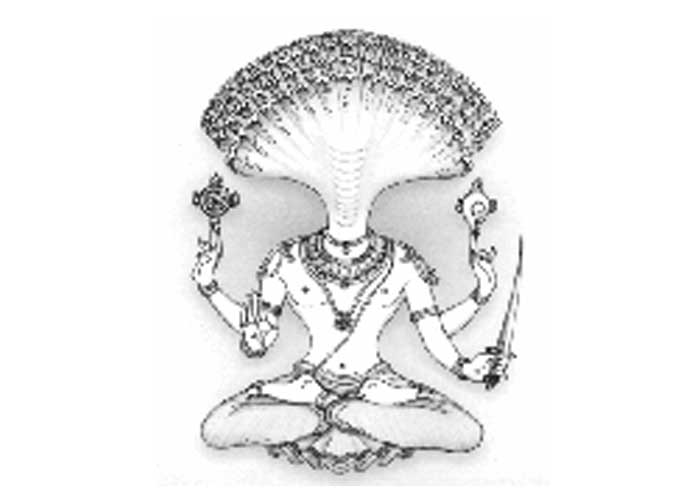A tradition of veterinary therapy developed very early in India. Based on Ayurveda, Indian veterinary medicine is known for its specialised literature, which provides information on methods of preventing and treating animal diseases. Some of these treatments are still practiced today.
Ancient Indian literature in the form of the Vedas, Puranas, Brahmanas, epics etc. is flooded with information on animal care, health management and disease cure. Atharva veda is a repository of traditional medicine including prescriptions for treatment of animal diseases. Scriptures such as Skanda Purana, Devi Purana, Matsya Purana, Agni Purana, Garuda Purana, Linga Purana, and books written by Charaka, Susruta, Palakapya (1000 BC), and Shalihotra (2350 BC) documented treatment of animal diseases using medicinal plants. Yajur veda cites importance of growth and development of medicinal plants and Atharva veda details the value of medicines in curing the diseases and provides interesting information about ailment of animals, herbal medicines and cure of diseases.
During Mahabharata period (1000 BC), Nakula and Sahadeva, the two Pandava brothers were experts of horse and cattle husbandry, respectively. Lord Krishna was an expert caretaker and conservator of cow husbandry. The ancient Indians were so apt with the knowledge of herbals, even Alexander acquired some of the skills used by Indians, particularly for treatment of snakebite. Graeco-Romans imported livestock from India after invasion by Alexander. These descriptions are available in Indika, a book authored by Megasthenes, the ambassador of Seleucus Nikator, king of Mecedonia, in the court of Chandragupta Maurya. King Ashoka (300 BC) erected the first known veterinary hospital of the world. He arranged cultivation of herbal medicines for men and animals in his empire and adjoining kingdoms. In the Arthashastra, composed by Kautilya, the guide and political advisor of Emperor Chandragupta Maurya, a lot of information is available about different animal departments – grazing lands, livestock products like skin and fur, and veterinary jurisprudence.
Elephant Medicine or Gaja Ayurveda
The Gautam Samhita, the Ashva Ayurveda and Hastya Ayurveda are the only treatises on animal science till now. Palakapya, an authority on elephant medicine belonged to the Rig vedic period and wrote Hastya Ayurveda or Gaja Ayurveda dealing with elephant medicine and dedicated to Lord Ganesha. Elephant medicine and surgery were divided into four parts, viz., Maha Rogsthan or major diseases, Ksudra Rogasthan or minor diseases, Salyasthan or surgery, and materia medica-diet and hygiene. Hastya Ayurveda also mentions about anatomy of elephant, treatment of different kinds of diseases, training of elephant, and also classification of elephants on the basis of a number of characteristics.
Equine Medicine or Haya Ayurveda
Salihotra is known to have been a specialist in the treatment of horses. He composed a treatise called Haya Ayurveda or Turan-gama-sastra or Salihotra Samhita, a work on the care and treatment of the horses. Haya Ayurveda is said to have been revealed to Salihotra by Brahma himself, the fountainhead of all knowledge. Two other works, namely Asvaprasnsa and Asvalaksana Sastram, are also attributed to Salihotra.
Veterinary medicine is theoretically divisible into eight branches, corresponding to the eight divisions set out in the Âyurveda – general surgery, general therapeutics, ophthalmology and otorhinolaryngology, care of foals (corresponding to Âyurvedic pediatrics), toxicology, fortifying treatments, demonology, and the use of aphrodisiacs.
Apart from surgical interventions, therapeutics usually consisted of the administration of medicinal preparations by different routes and in various forms: mixtures of powders, decoctions, electuaries, ointments and snuff. The principle remedies cited by the texts were based on plants, but some substances of animal or mineral origin were also used. All these natural ingredients served to prepare thousands of remedies, often of very complex formulation. The complexity of preparations is explained by the care taken to combine ingredients in order to counterbalance, enhance or prolong the effects of some ingredients through the effects of others. There are basic preparations to which various other ingredients are added to adapt the treatment to a given species. For example, the passage in the Carakasamhitâ (Siddhisthâna, XI, 20-26) concerning enemas for elephants, camels, cattle, horses and sheep provides a basic formula composed of the following plants: Acorus calamus L., Glycyrrhiza glabra L., Piper longum L., Randa spinosa Poir., Saussurea lappa C.B. Clarke. A dozen other plants may be added to these basic ingredients for elephant enemas. For cattle preparations, addition of decoctions of Butea monosperma (Lam.) Kuntze, Cedrus deodara (Roxb.) Loud. and Terminalia chebula Retz. was recommended. Other plants were indicated for horse enemas, such as Baliospermum montanum Muell.-Arg. or Croton tiglium L.
Cattle Management
Cattle husbandry was well developed during the Rig vedic period and the cow (Kamdhenu) was adored and considered the ‘best wealth’ of mankind. Vedic seers laid great emphasis on protection of cows.
Rig veda is replete with references to cattle and their management (Nene and Sadhale, 1997). References can be found on grazing of livestock, provision of succulent green fodder and water to drink from clean ponds, and livestock barns. Dogs were used to manage herds of cows and in recovering stolen cows.
In Krishi-Parashara (c. 400 BC), a description of a cattle shed is found. Cleanliness of the shed was emphasized. To protect animals from diseases, cattle sheds were regularly fumigated with dried plant products that contained volatile compounds (Bedekar, 1993).
Arthashastra mentions a government officer called the superintendent of cattle whose exclusive duty was to supervise livestock in the country, keep a census of livestock, and see that they were properly reared. The text directed that all cattle be supplied with abundant fodder and water and gives an elaborate description of ration that a bull, cow or buffalo should be supplied with. Maintenance of pastures around villages was encouraged. Manu presented that, “on all sides of a village, a space of 100 dhanus or three samya throws (in breadth) shall be reserved for pasture.” Fodder crops were cultivated and processed into silage – an old process in the Indian subcontinent as the word suyavasa in the Rig veda indicates. Cultivators also provided hay for their stock. In Agnipurana, kings were encouraged to preserve the breed of the cattle in the country.
Cow Medicine or Gau Ayurveda
Voluminous treatises are also available on cows, e.g., ‘Gau Ayurveda’. Mantras in Vedas (Shala Nirman and Goshth Suktas of Atharva veda) describe that the animal houses (Goshth) and their management were of good quality. Pashu Samvardhan Sukta of Atharva veda indicates that Vrihaspati Deva knew the animal behaviour and management well. Treatment of weak, infertile and unproductive cows for making them productive was well described.
Remedies still in use
Several Indian laboratories now make preparations from ancestral recipes for the treatment of domestic animals. Many of these medicaments are polyvalent, due to the multiplicity of ingredients used in their preparation. For example, a stomachic and tonic containing 59 ingredients from Ayurvedic texts is produced by a company in Bangalore. This preparation is recommended for treating digestive disorders (anorexia, dyspepsia, constipation, etc.) in cattle, sheep, goats, horses and dogs, in doses proportional to the size of these animals.
Another example is provided by an ointment against sprains and sores, prepared from the following plants: Abrus precatoriusL., Acorus calamus L., Celastrus paniculatus Willd., Hyoscyamus niger L., Moringa oleifera Lam., Nardostachys jatamansi D.C., Ocimum sanctum L., Saussurea lappa C.B. Clarke and Vitex negundo L. To these oils are added extracts of seven other plants: Anacyclus pyrethrum D.C., Colchicum luteum Baker, Curcuma amada Roxb., Gloriosa superba L., Litsea sebifera Pers., Myrica nagi Thunb. and Nerium odorum Sol. All these plants have been investigated and their active principles are known (1,6). Nardostachys jatamansi is often combined with oil of henbane (Hyoscyamus niger) as an antineuritic. Ocimum sanctum and Vitex negundo are used as wound dressing. In traditional medicine, the root of Curcuma amada is applied to contusions and sprains. Extract of Colchicum luteum is applied externally as an analgesic.
Many plants of the Ayurvedic pharmacopoeia have since been shown to be effective.
References:
http://www.oie.int/doc/ged/D8894.pdf
http://www.ncbi.nlm.nih.gov/pubmed/8038443
http://www.new1.dli.ernet.in/data1/upload/insa/INSA_1/20005abf_103.pdf
http://asianagrihistory.org/vol-10/veterniray.pdf
http://www.cbseacademic.in/web_material/Circulars/2012/68_KTPI/Module_6_3.pdf






Beautiful article which not only enlightens our history but also builds interest to know more …. expecting more of this type in future